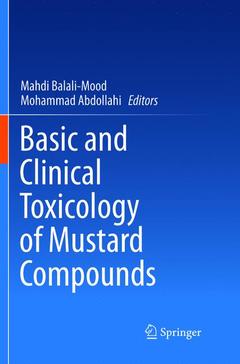Description
Basic and Clinical Toxicology of Mustard Compounds, Softcover reprint of the original 1st ed. 2015
Coordinators: Balali-Mood Mahdi, Abdollahi Mohammad
Language: English
Subjects for Basic and Clinical Toxicology of Mustard Compounds:
Publication date: 03-2019
408 p. · 15.5x23.5 cm · Paperback
Publication date: 12-2015
Support: Print on demand
Description
/li>Contents
/li>Biography
/li>Comment
/li>
This book offers a practical guide to the clinical management of sulphur and nitrogen mustard exposure including information on the history, pharmacology and toxicology of mustard compounds (MC).
Basic and Clinical Toxicology of Mustard Compounds details the many resulting complications of sulphur mustard (SM) poisoning such as respiratory, Dermatological, Ophthalmological and Psychiatric.
This volume is a key resource for clinical toxicologists, military and emergency physicians who are involved in the teaching and research of MC and for all medical and health professions who are responsible for the prevention, diagnosis and treatment of MC poisonings.
Chemistry of Mustard Compounds.- History of use and epidemiology of mustard compounds.- Basic pharmacology and toxicology.- Clinical pharmacology and toxicology of mustard compounds.- Delayed complications and long term effects of SM poisonings – Experience of Iraq-Iran war.- Upper respiratory complications of SM poisoning.- Lower respiratory complications of SM poisoning.- Dermatologic aspects of sulfur mustard exposure.- Ocular injury by mustard gas; early and late complications.- Immunological and hematological complications of sulfur mustard poisoning.- Psychiatric complications of sulfur mustard (SM) poisoning.- Genotoxicity, teratogenicity and mutagenicity of SM poisoning.- Verification of SM exposure in biological samples.- Occupational and environmental mustard exposure, prevention and chemical weapons convention.- Summary and conclusion
Mahdi Balali-Mood attended Tehran University, where he was awarded a B.Sc. First-Class Honor in Chemistry in 1963 and then an M.D. in 1970. After his medical military service and training in internal medicine and clinical toxicology, he was appointed an assistant professor in clinical toxicology and became the head of his newly established Poisoning Treatment Center (PTC) at Mashhad University in 1974. He was awarded a scholarship from the Ministry of Science of Iran and completed his Ph.D. in clinical pharmacology and toxicology at Edinburgh University Medical School (1978–1981). He continued at the school as a lecturer until 1982, when he decided to return to Mashhad to advance his established PTC.
Dr. Balali-Mood was promoted to associate professor and then full professor of medicine and clinical toxicology at the Mashhad University of Medical Sciences (MUMS) in 1984 and 1988, respectively. He has served as a clinical toxicology adviser to the International Programme on Chemical Safety (IPCS) and the World Health Organization from 1989 to the present. He has also been a member of the IPCS Programme Advisory Committee since 2000.
Dr. Balali-Mood was a founding member and the first president of the Iranian Society of Toxicology and was twice elected president of Irantox between 1989 and 2001. He has been a
member of the Iranian Academy of Medical Sciences since its establishment in 1990. In collaboration with a group of internationally recognized medical toxicologists, he founded the Asia-Pacific Association of Medical Toxicology (in 1989) and served as the organization’s first vice president and then as its president for 8 years (1994–2001). He was elected as a permanent member of the Academy of Sciences for the Developing World in 1997. He was also a member of the Scientific Advisory Board of the Organization for the Prohibition of Chemical Weapons from 2004 to 2011. Additionally, he is the co-founder of the Medical Toxi
A reference book for the pharmacologists and toxicologists who are involved in teaching and research on mustard compounds
A practical guide for the occupational, environmental, toxicological, military, medical, and health workers on safe use of MC and appropriate treatment of patients who receive NM and for possible SM exposure
Provides basic information on mustard compounds for regulatory authorities in different departments of works, environment, industries, military, and health




